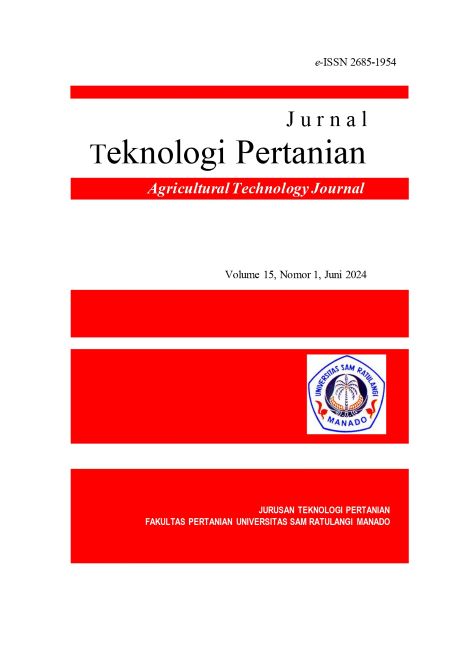The Effect of Dehydration on Leilem Leaf Characteristics (Clerodendrum minahassae Teijsm. & Binn)
DOI:
https://doi.org/10.35791/jteta.v15i1.55813Keywords:
leilem leaves, dehydration, rehydration ratioAbstract
The purpose of this study is to obtain a dehydration method that can preserve the characteristics of fresh leilem leaves. The method used in this study was a Complete Randomized Design (CRD) with 4 treatments i.e; A1 (Sunlight ±31-500C), A2 (Chiller ±4-80C), A3 (room temperature ±26-300C), and A4 (Oven 600C). Each treatment is repeated 3 times. Further research results are processed using ANOVA, if there is significount influence, it is continued with a 5% BNT test. The results showed that influence of various dehydration methods on color, water content, chlorophyll, vitamin C, and rehydration of leilem leaf. Dehydration using sunlight has an L* value of 26.63, 4,49% moisture content, 31.961 mg /L total chlorophyll, 0.027ppm vitamin C, and the rehydration ratio of 2.21. Leilem leaves dehydrated using Chiller have an L* value of 29.70, 12,60% moisture content, 45.792 mg/L total chlorophyll, 0.050 ppm vitamin C, and the rehydration ratio of 2.32. In the leilem leaf dehydration method room temperature has L* 28.67 strands, 5,54% moisture content, 41.281 mg/L total chlorophyll, 0.034 ppm vitamin C, and the rehydration ratio of 1.81. Leilem leaf dehydration using an oven has an L* value of 22.93, 3,05% moisture content, 42,132 mg/L total chlorophyll, 0.033 ppm vitamin C, and the rehydration ratio of 1.85. The best method dehydration of leilem leaves is under chiling temperature 4-80C in the chiller .The physicochemical properties of leilem leaves produced are green, showing the stability of chlorophyll pigment and has the highest water absorption of rehydration ratio.
References
Das A.2016. Studies on extraction and purification of Rebaudioside A and dehydration of Aloe Vera Gel. Indian Institute of Technology Guwahati India. PhD thesis.
Doymaz, I. (2009). Thin-Layer Drying Of Spinach Leaves In a Convective Dryer. Journal of Food Process Engineering, 32(1).
Emor, N., 2006, Isolasi dan Uji Aktivitas Antioksidan Ekstrak Daun Leilem (Clerodendrumminahassae L), Skripsi, Dr., Universitas Samratulangi, Manado, Indonesia.
Indrasti, D., Andarwulan, N., Purnomo, E.H., Wulandari, N. 2019. Klorofil Daun Suji: Potensi dan Tantangan Pengembangan Pewarna Hijau Alami. Jurnal Ilmu Pertanian Indonesi (JIPI). 24 (2) : 109-116.
Kakade, S., & V.S, N. (2014). Dehyration of Green Leafy Vegetable. India: Department of Food Engineering and Technology.1(8).
Kalangi, C., V.S., Kamu, & M. Kumaunang. 2014. Barcode DNA Tanaman Leilem (Clerodendrum minahassae L.) Bersarkan Gen matK. Jurnal Fakultas Matematika dan Ilmu Pengetahuan Alam, Universitas Sam Ratulangi, Manado. 3(2) : 108-112
Kurniawati, E., Riandini, H.M. 2019. Analisis Kadar Vitamin C Pada Daging Buah Kelengkeng (Dimocarpus longan L.) Segar dan Daging Buah Kelengkeng dengan Metode Spektrofotomtri UV-Vis. J-HESTECH, 2(2): 119-126.
Murti, K. (2017). Pengaruh Suhu Pengeringan Terhadap Kandungan Vitamin C Buah Cabai Keriting Lado F1 (Capsicum Annuum L). Jurnal Keteknikan Pertanian Tropis dan Biosistem, 5(3), 245-256.
Musaddad, D. (2008). Pengaruh Media, Suhu, dan Lama Blansing Sebelum Pengeringan terhadap Mutu Lobak Kering. Jurnal Hortikultura. 18(1):87-94.
Nguyen T. V.L, T.V., Vo, T.D. Lam dan L.G., Bach. 2019. Water Blansing Conditions on The Quality of Green Asparagus Butt Segment (Asparagus officinalis L.) Materials Today: Proceedings, 8(2019): 4799-4809.
Rohmat, N., Ibrahim, R., & Riyadi, P. (2014). Pengaruh Perbedan Suhu dan Lama Penyimpanan Rumput Laut Terhadap Stabilitas Ekstrak Kasar Pigmen Klorofil. Jurnal Pengolahan dan Bioteknologi Hasil Perikanan, 3(1), 118-126.
Santamaria, P.A., Gomez M.L.C., Gutierrez A.B.H., & Roberto M.I.E. Influence of drying method on steviol glycosides and antioxidants in Stevia Rebaudiana leaves. Food Chemistry 172. 2014:1-6.
Setyowati, A., Hidayah, I. M., & Suryani, C. L. (2017). Pengaruh Variasi Jenis Pengering Terhadap Karakteritik Fisik, Kimia dan Sifat Antioksidatif Tepung Daun Pandan Wangi. Yogyakarta: Fakultas Agroindustri Universitas Mercu Buana.
Setyowati, A., Hidayah, I. M., & Suryani, C. L. (2017). Pengaruh Variasi Jenis Pengering Terhadap Karakteritik Fisik, Kimia dan Sifat Antioksidatif Tepung Daun Pandan Wangi. Yogyakarta: Fakultas Agroindustri Universitas Mercu Buana.
Suyitno. 2010. Deterinasi Pigmen dan Pengukuran Kandungan Klorofil Daun. Prosiding Pelatihan Guru–guru Biologi RSBI DIY. Yogyakarta, 7 Agustus 2010.
Winangsih & Prihastanti, E.P.S. (2013). Pengaruh Metode Pengeringan Terhadap Kualitas Simplisia Lempuyang Wangi (Zingiber aromaticum L.). Buletin Anatomi dan Fisiologi, 21(1),19-25.
Additional Files
Published
Issue
Section
License
Copyright (c) 2025 Reniaty Rombelayuk, Maria Fransisca Sumual, Lana E. Lalujan

This work is licensed under a Creative Commons Attribution 4.0 International License.


 Journal Template
Journal Template


